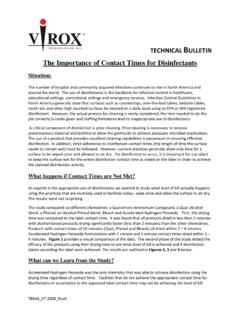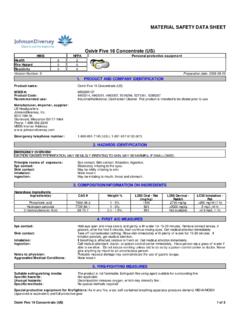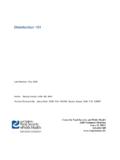Transcription of ISOLATION ROOM Cleaning and Disinfection Protocol for ...
1 ISOLATION room Cleaning and Disinfection Protocol for Clostridium difficile This document has been developed in accordance with current applicable infection control and regulatory guidelines. It is intended for use as a guideline only. At no time should this document replace existing documents established by the facility unless written permission has been obtained from the responsible facility manager. PREFACE C. difficile is a spore forming bacteria which can be part of the normal intestinal flora in as many as 50% of children under age two and less frequently in individuals over two years of age. C. difficile is the major cause of pseudomembranous colitis and antibiotic associated diarrhea.
2 C. difficile-associated disease occurs when the normal intestinal flora is altered, allowing C. difficile to flourish in the intestinal tract and produce a toxin that causes a watery diarrhea. Repeated enemas, prolonged nasogastric tube insertion and gastrointestinal tract surgery increase a person's risk of developing the disease. The overuse of antibiotics, especially penicillin (ampicillin), clindamycin and cephalosporins may also alter the normal intestinal flora and increase the risk of developing C. difficile diarrhea. Individuals with C. difficile-associated disease shed spores in the stool that can be spread from person to person. Spores can survive up to 70 days in the environment and can be transported on the hands of health care personnel who have direct contact with infected patients or with environmental surfaces contaminated with C.
3 Difficile. Strict adherence to hand washing techniques and the proper handling of contaminated wastes (including diapers) are effective in preventing the spread of the disease. Environmental surfaces contaminated with C. difficile spores should be cleaned with an effective disinfectant. Limiting the use of antibiotics will lower the risk of developing C. difficile diarrhea. INFECTIOUS AGENT1 NAME: Clostridium difficile SYNONYM OR CROSS REFERENCE: N/A CHARACTERISTICS: Gram positive rod, anaerobic, motile, subterminal spores, produces a cytotoxin and enterotoxin HEALTH HAZARD PATHOGENICITY: Opportunistic pathogen, broad-spectrum antibiotic therapy eliminates competing gut flora, allowing the overgrowth of C.
4 Difficile; important cause of antibiotic-associated diarrhea and pseudomembranous colitis; diarrhea in cancer patients receiving chemotherapy; symptoms range from mild diarrhea to serve colitis (possibly fatal). EPIDEMIOLOGY: Worldwide; 2-3% of adults are asymptomatic carriers; 50% of healthy neonates (, 1 year old) are carriers; nosocomial transmission increasingly important. HOST RANGE: Humans and other animals INFECTIOUS DOSE: Not known MODE OF TRANSMISSION: Fecal-oral contact; evidence for transmission via fomites and hands exists. INCUBATION PERIOD: Not known, some evidence shows 1 to 10 days. COMMUNICABILITY: May be transmitted from person to person. 1 Public Health Agency of Canada ISOLATION room Cleaning and Disinfection Protocol for Clostridium difficile Preparation C.
5 Difficile-associated disease shed spores in the stool that can be spread from person to person. Spores can survive up to 70 days in the environment and can be transported on the hands of health care personnel who have direct contact with infected patients or with environmental surfaces contaminated with C. difficile. Strict adherence to hand washing techniques and the proper handling of contaminated wastes (including diapers) are effective in preventing the spread of the disease. Environmental surfaces contaminated with C. difficile spores should be cleaned with an effective disinfectant. Appropriate personal protection must be taken for those responsible for the decontamination of a room or area.
6 Personal Protection Equipment (PPE) 1. Disposable gloves. Gloves should be changed as required, when torn, when hands become wet inside the glove, when soiled, when moving between dirty and clean zones in the patient room and between patient rooms or designated patient space 2. Household gloves can be worn, but they must be discarded when the Cleaning is complete. 3. Gowns 4. Protective Eye wear (goggles, face shield or mask with eye protection) as needed 5. Masks (surgical or procedural masks are sufficient) as needed Products Accelerated Hydrogen Peroxide Sporicidal Gel (sold as STBC and RESCUE Sporicidal Gel) for Cleaning and Disinfection of sinks, toilets, commodes and basins.
7 Tuberculocidal Accelerated Hydrogen Peroxide Surface Disinfectant (sold as Accel INTERV ention, Accel PREV ention, Accel TB or Oxivir Tb) Product Germicidal Efficacy The AHP Sporicidal Gel product has been proven effective as a 10 minute Sporicide indicating a viable 6 Log reduction against Bacillus subtilis, Clostridium sporogenes and Clostridium difficile. AHP TB products are Health Canada registered Intermediate Level Disinfectants that carry a broad-spectrum sanitizing claim and bactericidal claim indicating a 6 Log reduction against Vegetative Bacteria including as well as a General Virucide claim against both enveloped and non-enveloped viruses as well as a Tuberculocidal claim against Mycobacterium spp.
8 Refer to product labels for additional claims and product specific contact times. Procedures Summary Inform housekeeping when a patient has C. difficile. Wear appropriate PPE as defined by the ISOLATION Sign. Isolations Rooms should be cleaned and disinfected twice per day in accordance with Infection Control guidelines. Direct patient care equipment such as stethoscopes, BP cuffs, commodes etc may be dedicated to the patient s use. If not dedicated, equipment must be cleaned and disinfected between patients as the organism can be transmitted from one patient to another via shared items. ISOLATION room Cleaning and Disinfection Protocol for Clostridium difficile Flush toilet and thoroughly rinse the sink and commode (if present).
9 Apply the AHP Sporicidal Gel to the toilet, sink and commode ensuring the surfaces are adequately covered using a clean cloth or brush. Change gloves and wash hands before beginning to clean the patient room . Apply the AHP-TB solution to either surface or to cloth. Clean and disinfect all hand contact surfaces of the room by reapplying the AHP-TB Solution and allowing for the appropriate contact time as listed on the label. If using cloth & bucket method, do not double dip Cleaning cloths. Periodic rinsing of soft surfaces such as vinyl or Naugahyde is suggested. Once the patient room has been cleaned and disinfected, proceed to the Patient Bathroom. Clean and disinfect all hand contact surfaces in the bathroom that were not previously addressed with the AHP Gel by moving from cleanest to dirtiest surfaces.
10 Rinse sink to ensure all Gel Residue has been removed. Scrub the inside of the toilet and flush to ensure all Gel residue has been removed. Remove PPE prior to leaving room and wash hands. Recommended Procedures for Cleaning and Disinfecting Patient Rooms 1. Check door to see if the ISOLATION Precaution Sign is present (Contact Precautions). Follow ISOLATION Precaution requirements for PPE. Goggles should be used in addition to PPE when using the AHP Sporicidal Gel. 2. Gather all supplies/equipment and Cleaning solutions required and leave supply cart outside of door of patient room . 3. WASH hands and put on PPE prior to entering room . Personal protective equipment should be changed if torn or soiled and between patient rooms.







